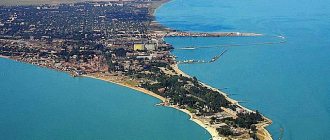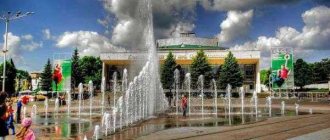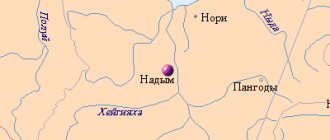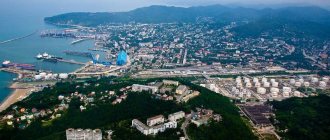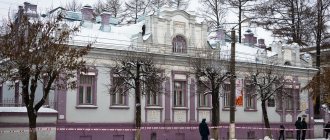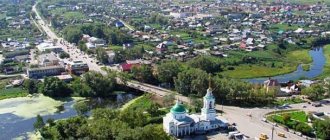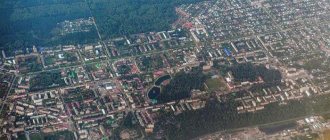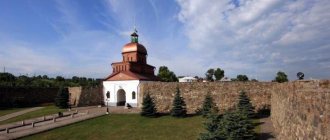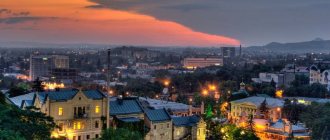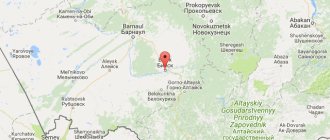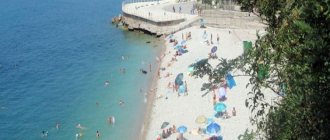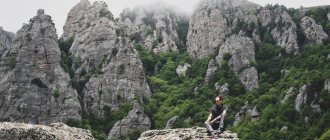One of the popular resorts in Kuban is the city of Yeysk, located on the shores of the Azov Sea, 170 km from Rostov-on-Don and 250 km from Krasnodar.
The city is located on the Yeisk Peninsula, washed on both sides by the sea. On the one hand, this is the Beysug Estuary and the Sea of Azov, on the other, the Taganrog Bay and the Yeisk Estuary, into which the Yeya River flows. Sand spits Yasenskaya, Yeiskaya, Kamyshevatskaya, Dolgaya extend from the peninsula into the sea.
Near the city there is Lake Khanskoye, whose sulfate mud is used in sanatorium treatment.
It is believed that Kuban begins with Yeisk, as the northernmost city of the Krasnodar Territory.
Climate
The fame of the southern resort was created by Yeysk’s excellent climate; one of its features is the absence of sudden temperature changes. Where the city of Yeysk is, the mild winter does not last long, snow usually falls for 1-2 weeks, but frosts do occur.
But summer begins in May and ends at the end of September. The average air temperature in May and September is +17, in the summer months +25. With an air humidity of 60%, this represents comfortable weather. In summer there are thunderstorms and a refreshing wind often blows.
In May they begin to swim, because... the water warms up to 18 degrees. In June-August, the water temperature off the coast is at least +23…+26. In September, the water and air temperatures become equal, and the velvet season begins.
Dolzhanskaya Spit
The Long Spit is a picturesque natural monument. By the name of the village located at its base, the spit is also often called Dolzhanskaya. There are clean sandy beaches with beautiful shells, as well as kite and windsurfing schools. You can almost always catch a good wind on the spit, so Dolgaya attracts sailing enthusiasts from all over the country.
The size of the spit is constantly changing; now its length is about 10 kilometers. This sandy barrier separates the Taganrog Bay from the Sea of Azov. The water on one side and the other actually looks different: to appreciate it fully, you need to be at the very edge of the spit.
Dolzhanskaya Spit is a popular place among fans of wild recreation; there are also many paid campsites lined up along the spit.
Recreation centers on Dolzhanskaya Spit : Veterok, Raduzhnaya.
History of the city of Yeisk
A convenient port on the Yeisk Peninsula in the Middle Ages was often used by sailing Genoese traders, sheltering from the storms of the Sea of Azov. A small town appeared at the end of the 18th century. as a residence for Khan Shan-Girey, supported by Russia. It was here that a manifesto was voiced in 1783, which secured the rights of the Russian Empire to Crimea and Kuban. In 1848, Prince M. Vorontsov supported the proposal of Ataman G. Rasp to build a port city.
In a couple of years, the city was thoroughly rebuilt, but soon suffered greatly during the Crimean War.
During the Civil War, fierce battles took place for Yeysk; it was a symbol of the “red” power.
In the 30s, industry began to develop in Yeisk, a military pilot school appeared, from which about 300 Heroes of the Soviet Union emerged.
During the Second World War, Yeysk was occupied; restoration began immediately after the Nazis left in 1943.
Khanskoye (Tatar) Lake
A closed steppe reservoir sixty kilometers from Yeisk, in the southern part of the Yeisk Peninsula. The length of the lake is about 16 km, width - from 6 to 7 km, maximum depth (in spring) - up to two meters, in summer - only 5-10 cm. The magnesium-sodium and sulfate-chloride water of Lake Khan is saturated with minerals and salt. In ancient times, in the summer, during drying out, table salt was mined from the bottom of the lake, and the income from this fishing went to the treasury of the Crimean Khan, who, after the annexation of Crimea, could no longer live, as before, by predatory raids on Russian lands and became a vassal of Russia.
Summer on Khanskoye Lake.
Nowadays table salt is not mined here. But medicinal mud and brine - yes. The composition is similar to the mud of Lake Saki, Odessa Estuary, and Tambukan Lake in Pyatigorsk. It helps to cope with diseases of the nervous and cardiovascular systems, digestive organs, joints, and maintain the freshness and beauty of the skin. The flora and fauna around the reservoir is also rich. Especially ornithological - cormorants, pelicans, flamingos, and laughing gulls live in its vicinity.
Architectural features
Yeysk was built according to the general plan, which was personally approved by Emperor Nicholas I. According to the plan, the streets were located perpendicular to each other. In the architectural appearance of the city center you can find all the styles that Russian architects used.
The houses of the city of Yeisk in the central region represent unique examples of architectural art of the 19th-20th centuries, about 330 buildings are architectural monuments.
Townspeople remember the names of merchants - owners of mansions in which banks, pharmacies, shops, and hairdressers were located. Among the houses that attract attention are Gostiny Dvor, the Main Post Office, and the house of the district administration.
Some streets still have cobblestone paving. At the end of the 19th century. The city authorities figured out how to pave the roads: all ships moored in the port had to bring stone as ballast, which was used for the road surface. The streets of the city of Yeisk allow you to get an idea of the ancient appearance of the city; it is worth taking a walk along Sverdlov, R. Luxembourg, and the Taganrog embankment. Of interest is Shmidt Street, which has only an odd side, while the even side is in Mariupol, located across the strait.
Today, officially, there are several districts in Yeisk, including a military town, a port and industrial zone, the Solnechny microdistrict, New Massif, Shirochanka.
Improvement. Environmental threats
While the improvement of the tourist center and embankments is on par, in other areas not everything is so rosy. For example, the asphalt surface of the roads is in poor condition.
Environmental threats of concern:
air pollution on the Krasnodar-Eysk highway;
launch of an oil loading terminal;
deterioration of treatment facilities;
spontaneous landfills.
The city administration imposes fines on violators of landscaping rules and regularly holds environmental cleanups.
Yeysk Schools
Educational institutions are located throughout Yeysk. There are city schools in all districts. There is a high percentage of graduates entering prestigious universities in the country. Educational institutions of various specializations are represented in Yeysk:
- 12 municipal budgetary educational entities;
- 1 evening;
- 4 boarding schools, of which 3 are correctional, 1 is for orphans;
- Cossack cadet corps, which is the largest in the Krasnodar region;
- 1 gymnasium;
- 2 art schools;
- 2 Youth and Youth Football Schools;
- Youth and Youth Sports School for children of the Olympic reserve.
The “Network City” system operates in educational institutions; in Yeisk, all schools are covered by it. Electronic journals and diaries are available to children, parents and teachers on a variety of mobile devices.
The “Network City” system in Yeisk allows you to control the educational process, which leads to an increase in the educational level.
The city offers training in 4 colleges, 2 vocational schools, as well as university branches.
Economics[edit]
How the city remains a mystery after the closure of most large enterprises. If before 1991 there were 18 large enterprises, then by now only three of them remain: 570 ARZ (still alive), (more dead than alive) and beer (the only one that is developing and periodically receives prestigious awards). There is a certain layer (about 15%) of the population that lives exclusively at the expense of vacationers, young people work in eateries, Euronetworks and other connected people, schoolchildren ride bananas, in short, entertain each other. They say that it is difficult to find a job in Yeysk. This is not true, there is work, just open any newspaper. It’s just that smart young people leave for Rostov-Krasnodar-Moscow-St. Petersburg and return only in old age, and not very smart young people don’t want to go to vocational schools, they receive unhelpful diplomas from university branches, without getting the desire to work and knowledge. As a result, no one needs such workers even in Yeisk. At the same time, collective farmers who trained as masons and other proletarian professions receive considerable money by local standards. In general, military pensioners live best in Yeisk, because their average pension is equal to the average salary, plus most of them are not old and earn quite good money in their normal lives.
On holiday in Yeysk
In Yeysk there are sanatoriums, boarding houses, many hotels, recreation centers, hotels and campsites; since 2006 the city has resort status.
About 400 thousand people come to the city of Yeysk (Krasnodar Territory) every year for vacation. The main directions of the resort city:
- Yeysk is often chosen by families with children, because the warm, shallow sea with sandy beaches is an excellent place to spend a vacation with kids.
- Mineral waters and therapeutic hydro-carbonate-sulfate and magnesium-calcium muds attract those who want to improve their health. The effectiveness of mud therapy in Yeisk is not inferior to foreign clinics.
- The climatic features of the region are optimal for kitesurfing, windsurfing, and yachting. Kitesurfing competitions and a yacht festival are held annually in May.
- Horseback riding, hiking, parachute jumping, fishing and hunting - all this can be done in Yeysk.
Cathedral of St. Nicholas the Wonderworker and the Temple of Michael the Archangel
The Cathedral of St. Nicholas the Wonderworker is the largest temple in the city of Yeysk. It was built in the late 90s/early 2000s on the site of the old Panteleimon Church, destroyed in the early 1930s by the Bolsheviks. This temple existed since 1890, next to the cemetery where prominent people of the city were buried.
Address: Panteleimonovskaya Square, 1.
The Church of the Archangel Michael became the first stone church in Yeisk. It was erected from 1860 to 1865. The temple was destroyed in 1938, and at the turn of the 90s and 2000s it was rebuilt. The church is surrounded by the picturesque Mikhailovsky Garden. She runs a Sunday school.
Location: st. Yanysheva.
Yeisk beaches
The beach line stretches for 2.5 km along the western and eastern sides of the city; the beaches are divided into wild and comfortable. The well-maintained ones, which are located on the Yeisk Spit, have the infrastructure necessary for recreation. Wild ones are located along the railway line along the shore of the estuary.
The water in the sea is most often cloudy, but this is not mud, but a significant amount of silt impurities that are beneficial to health.
The best beaches in Yeysk:
- Central. 500 m of the beach line are located in the Taganrog Bay, so there are waves here. The beach is fine sand mixed with shells. At a distance of 60-70 m from the shore, the depth does not exceed 1.5 m. There are lifeguards on the beach, there is a first-aid post, toilets, changing cabins, rental of sun loungers and umbrellas.
- Children's, or Goat, or Melyaki. A small, only 300 m, beach is located to the left of the city port in Taganrog Bay. This territory has the shallowest sea, so the water warms up already in May. The waves bring a huge amount of sand, in which kids love to play. There are shops and cafes on the beach, and there is a water park nearby.
- Another beach in the Taganrog Bay is Kamenka, the name indicates that the kilometer-long coastal strip consists of small stones, which turn into sand at a distance of 2 m from the shore. The depth of the sea is 1.5 m. There is a cafe, a dolphinarium and an aquarium on the beach.
- The next beach on the bay is Vista. It is also quite rocky, with a gentle slope into the sea. There is a playground for children, a cafe, and recreational goods for sale. Vista turns into the Precipice beach, strewn with large pebbles.
- On the spit there is the oldest well-maintained beach in the city - Molodezhny. It attracts lovers of active recreation; there is a car camping site, a volleyball court, bars, clubs, and discos. The peculiarity of the beach is a sharp entrance to the water and strong undercurrents. There is a windsurfing and kitesurfing school on Molodezhny.
Along the shore of the Yeisk Estuary there are both comfortable and wild beaches, including nudist ones. The bottom is usually shallow and covered with silt.
Monument to Prince Vorontsov
An equestrian sculpture depicting one of the founders of Yeisk - the Caucasian governor, Prince Vorontsov. He supported the initiative of the Kuban ataman Grigory Rasp to found a port city near the Yeisk Spit. It is interesting that when creating the monument, a portrait of the prince, stored in the Hermitage, was used.
Monument to Prince Vorontsov.
Location: Nizhnesadovaya street, on the square in front of the city stadium.
Attractions
There are more than 600 monuments in the Yeisk region, among them:
- monuments to famous people whose lives were connected with the city (N. Mordyukova, S. Bondarchuk, V. Vysotsky, Prince Vorontsov, A. Pushkin, etc.);
- military-patriotic memorials (armored boat, tank, etc.);
- religious.
There are museums in Yeysk:
- historical and local history;
- memorial I. Poddubny;
- art.
In the city center there is a variety of entertainment that is interesting for both children and adults:
- Shark Reef Oceanarium;
- dolphinarium;
- crocodile canyon;
- Nemo water park with 15 water slides and 7 swimming pools;
- ice palace "Snezhinka";
- children's;
- Premier cinema.
In the village of Morskoy there is an ethnographic complex “Kubansky Farm”.
In summer, excursions are organized to the Long Spit, where you can windsurf, kitesurf, fish, and the Island of the Seven Winds, inhabited by many birds.
Department of Housing and Utilities
In general, the situation with housing and communal services in Yeisk is not bad. The city is electrified and gasified. Sewerage is available in most areas, although not everywhere. The only negative is the water supply. Due to wear and tear of the water supply system, interruptions in the supply of water (both cold and hot) often occur. There is not enough pressure, so on the upper floors of multi-story buildings, water may not flow well into the taps. In some areas the water is turned off at night.
The situation is better in the private sector. The same applies to new housing complexes. Pumps and small boiler rooms are installed there. Special containers are installed in areas where water is accumulated and, if necessary, pumped from there into the resident’s water supply system. Private owners are also lucky with heating: it is autonomous, which allows you to regulate the temperature in the room yourself.
As for the price tags on housing and communal services receipts, they are quite significant.
City parks
The city of Yeysk is considered the greenest in the Krasnodar region. The largest and oldest is I. Poddubny Park, where there is a museum dedicated to him and the grave of the legendary wrestler is located.
The vast territory presents all types of attractions produced by the local factory. The 150-year-old park is a wonderful place to relax; there are fountains, benches, playgrounds everywhere, alleys with elegant flower beds, and concerts are held on summer stages.
Nearby there is a park named after. Gorky, decorated with small architectural forms, monuments, in the center of it is the St. Michael the Archangel Church. On the temple grounds there is a pond with swans and pens where poultry live.
Squares in the city of Yeysk are located in the center and on the outskirts.
Primorsky Park is located near the Taganrog embankment.
There is a round park in the city - Nikolsky, this oldest park in the city is famous for its spring.
Taganrog embankment
The embankment along Kamenka beach, locals call it Primorskaya embankment. Stretched for 2 km along Schmidt Street. Taganrog embankment is the main promenade of Yeysk. Well-maintained, with all the necessary infrastructure for recreation and walking - benches, cafes, bars, children's amusement parks, a small oceanarium, funny monuments, and a 27-meter Ferris wheel. The embankment runs along the ridge of the hill, the beach is located below, offering beautiful sea views.
Public transport
It is convenient to get around the city of Yeysk by minibus. The fare is 15 rubles.
Minibuses go to all areas, there are 7 directions, the most popular:
- to city beach No. 2, 8;
- to Kamenka beach No. 14, 7, 4;
- to the park named after Poddubny No. 11, 7, 4, 1.
All routes pass through the central market. 2 routes are served by city bus.
Transport services are also provided by taxis, the cost of a trip around the city is 50-150 rubles.
Where can you save money?
In general, Yeysk is an economy class resort city. Local residents treat visitors kindly. The local population is not spoiled by money. Accordingly, the prices here are pleasantly surprising. If you want to save money, then it is better to live in the private sector. A room per night costs from 100 to 200 rubles. Hotels are available everywhere, and if the rooms are without any frills, the prices are also very affordable. But there are, of course, luxury options.
Public transport is well developed. There are minibuses that travel around the city for 5 rubles, regular methane buses for 3 rubles, but they are big. From any part of the city there is certainly a route to the market. The Central Market is the place where all city life is concentrated in the morning. Buying groceries is not a problem here. The meat on the market is fresh, fresh and inexpensive, but a wise person must buy it, otherwise they can slip you anything they want. Fruits and vegetables are sold in abundance. Prices “for our own people” and for visitors differ by approximately half, but it’s still nice to buy a kilogram of young cherries for 40 rubles, and a kilogram of cherries for 20. A portion of shish kebab can be purchased for 50-70 rubles (on the Black Sea - rubles for 120- 200). And in a local restaurant for 150 rubles you can “burst twice.”
Winemaking and wine drinking are very developed among the indigenous population. The range of wines sold by the glass covers the entire coast and all of Krasnodar, as well as Georgia and other adjacent regions. If in a small cellar you see a modest inscription “wines by the glass”, be sure that here you will find at least fifty varieties.
The local cuisine is also quite unique. Usually residents of Yerevan make everything for themselves - cutlets, dumplings, and kebab. The food here is thick and fatty, and the salt is eaten almost by the spoonful. The restaurants mostly serve not local Krasnodar cuisine, but Tatar or Kazakh cuisine. In general, you can “catch” food anywhere, inexpensively and tasty.
How to get to Yeysk
It is convenient to get to the city of Yeysk (Krasnodar Territory) by various means of transport.
- Trains depart from the railway station to Moscow, St. Petersburg and daily trains to Starominskaya-Timashevsk.
- The bus station is located on the street. Kommunisticheskaya, 18. Every day buses make trips to the cities of Armavir, Belaya Kalitva, Geledzhik, Gukovo, Maykop, Novorossiysk, Novo- and Staroshcherbinovskaya, Pyatigorsk, Rostov-on-Don, Stavropol, Taganrog, Tikhoretsk, Shabelskoye. 6 flights depart to Krasnodar every day.
- The most convenient way to travel to Yeysk is by car. From the M-4 highway outside Rostov-on-Don, you can turn onto R-268 and drive about 160 km.
The airport is under reconstruction and is currently used only for cargo transportation. Therefore, many vacationers choose a composite route: they fly to the airport of Krasnodar or Rostov-on-Don, then take a bus to Yeysk.
Interesting facts[edit]
Treasure map
- Yeysk is one of the few cities that was immediately founded as a city, and did not receive this status.
- There are no traffic jams in Yeisk (except for the summer resort period).
- In Yeysk, minibuses pay at the exit, not at the entrance, and you cannot ride while standing.
- It is correct to call a resident of Yeisk “Yechanin” and not “Eyets”.
- There is no sea in Yeisk, only a bay and an estuary.
- Although I.M. Poddubny is called a Yeychanin, he was not born in Yeisk.
- The streets of the northern (“old”) part of Yeisk are straight, but after Bogdan Khmelnitsky and Berdyanskaya streets they noticeably curve in different directions of the steppe, forming separate areas.
- You shouldn’t think that everyone in Yeysk lives at the expense of vacationers, this offends the locals.
- Yeysk has its own slang for referring to vacationers: “bark beetle” or “katsap” (if the bark beetle is from the Moscow region, from Moscow itself there is such an insignificant number that it can be neglected), there are no “bzdykhs” here. This is how they calculate authors from the Black Sea coast who write angry comments.
| Cities of Krasnodar • Goryachy Klyuch • Korenovsk • Krymsk Kurganinsk • Novorossiysk • Armavir • Slavyansk-on-Kuban Tikhoretsk • Timashevsk • Ust-Labinsk • Kropotkin Resorts Sochi • Gelendzhik • Dzhubga • Tuapse • Anapa • Yeisk • Taman Stanitsa Blagoveshchenskaya • Staroshcherbinovskaya • Elizavetinskaya • Ataman • Staronizhesteblievskaya Districts Beloglinsky • Belorechensky • Bryukhovetsky • Gulkevichsky • Kushchevsky Novokubansky • Novopokrovsky • Seversky • Starominsky • Uspensky Water Black Sea • Azov Sea • Kuban River • Krasnodar Reservoir • Mzymta |
